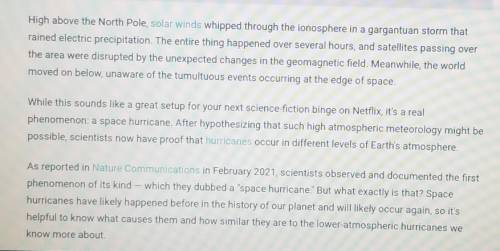
Biology, 09.04.2021 21:30 sophiateaches053
(Read the article) 1. Tell me the main idea. 2. what was discovered/found out? 3. what did you learn and/or what was most interesting to you in the article 4. what other questions do you have after reading this article. The worlds first (documented) space hurricane According to the research published by a team of international scientists, the first documented space hurricane occurred on Aug. 20, 2014. High in the upper atmosphere, a spiral of plasma stretching more than 600 miles (1,000 kilometers) across, swirled above the magnetic North Pole for nearly eight hours. While it was invisible to human eyes, weather satellites were affected and tipped researchers off to the activity. "Like many space weather phenomena, charged particles from the sun interacted with Earth's magnetic field to spark the space hurricane," explains Accuweather meteorologist Brian Lada, who specializes in astronomy and space coverage. "This phenomenon is likely being called a 'hurricane' due to the way that it spins, similar to a tropical cyclone," explains Lada. "Since it was observed over the North Pole, I was a little surprised that they didn't nickname it a 'space vortex' to match the viral weather term 'polar vortex.'" Space hurricane vs. earth hurricanes Given that they share the same name, space and Earth hurricanes must be similar, right? In fact, they do have some aspects in common — but they're also quite different. Aside from shape (both have an eye at the center and arm bands of storm activity), space and Earth hurricanes are similar in another important way — they both have precipitation. "Hurricanes that we are familiar with have liquid precipitation (rain), while space hurricanes have electric precipitation that can create stunning aurora. However, the aurora caused by this specific space hurricane may have gone unnoticed by people on the ground as it occurred during the summer in the Northern Hemisphere, the worst time of the year to look for aurora since the days far outlast the nights," says Lada. Hopefully the next one will occur during the winter months so we can enjoy the show. But there's also one big difference between the two types of hurricanes. "The two occur in completely different portions of Earth's atmosphere," Lada continues. "Normal hurricanes occur in the troposphere, the part of the Earth's atmosphere that is closest to the ground that extends upward of around 5 to 9 miles [8 to 14 kilometers]. The space hurricane was observed in the ionosphere, which extends anywhere from 50 to 600 miles [80 to 966 kilometers] above Earth's surface." The space hurricane was also huge compared to an Earth hurricane; at more than 600 miles wide, that's roughly twice the average diameter of hurricanes in the troposphere. The reasons for space hurricanes So, what caused this space hurricane? Scientists aren't quite sure yet. But there are some theories. The main one concerns the electromagnetic conditions in 2014: The sun was at the maximum of its most recent 11-year cycle, and August was a time of "low solar and otherwise low geomagnetic activity" according to the research in Nature Communications. This low activity in the ionosphere was likely similar to hurricane-conducive conditions that help cause hurricanes on Earth, says AccuWeather senior meteorologist and astronomy blogger David Samuhel. "It seems like it occurs when conditions are quiet," Samuhel says. "There was very little geomagnetic activity, [and] solar wind was low. This reminds me of hurricanes. "[Hurricanes need] light winds aloft, so thunderstorms can form and rotate around a center without the strong winds aloft pulling them away from the center," Samuhel adds. "Once the center gets established, the thunderstorms become stronger and stronger and thus spin faster around the center until strong winds aloft pull them apart." So, it's likely that the right combination of high atmospheric conditions came together to allow the space hurricane to form — and to dissipate when those conditions changed. Should we fear space hurricanes According to Lada, space hurricanes are mostly harmless — though it's possible we could experience the effect of one on Earth. "If strong enough, a space hurricane could potentially cause some disruptions on the ground. If there are enough charged particles raining down from space. In addition to creating aurora, it could disrupt GPS signals, radio waves and in extreme cases, the power grid," Lada explains. "However, if this event only happens over the poles, then the number of power outages would be limited based on the sparse population of the polar region." Having "discovered" this first one, scientists will undoubtedly be trying to determine where — and how often — space hurricanes occur. But it's likely we don't need to have too much concern about them compared with their earthly counterparts.


Answers: 2


Another question on Biology


Biology, 22.06.2019 13:50
Interactions between organisms and their environment impact the organism’s overall population. the jaguar panthera onca is the largest cat in north america. it is found in areas across the southwest, including arizona, new mexico, and texas. it is a carnivore that has powerful jaws and sharp teeth and preys on fish, turtles, tapirs, and many smaller mammals. which shows the relationship between the jaguar and turtles?
Answers: 3


You know the right answer?
(Read the article) 1. Tell me the main idea. 2. what was discovered/found out? 3. what did you learn...
Questions


Mathematics, 04.08.2019 04:00



Health, 04.08.2019 04:10

Mathematics, 04.08.2019 04:10


Mathematics, 04.08.2019 04:10


Mathematics, 04.08.2019 04:10

Mathematics, 04.08.2019 04:10

Mathematics, 04.08.2019 04:10





Spanish, 04.08.2019 04:10

Spanish, 04.08.2019 04:10


History, 04.08.2019 04:10



